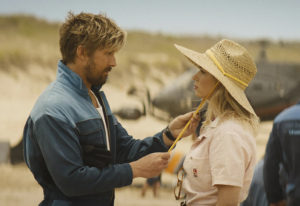Behind every great artist is the person who does all the actual work. For instance, no pop star born outside Liverpool has ever written their own songs. Dostoyevsky used to compose his novels by pacing the floor and dictating to his wife, who would transcribe and shape his rants into a narrative that would pay off his gambling debts. Even I, literary wunderkind, rely on an editor to hack my paragraphs into something resembling coherent thoughts.
“The Fall Guy” (now in theaters, starring Ryan Gosling and Emily Blunt) is not about ghostwriters, but another profession in the category of unsung heroes: stuntmen.
The modern stuntman is what happens when someone in a film studio’s accounting department runs the numbers and realizes it will cost them more money than they’ll save if the lead dies. So instead, they hire someone of his/her approximate height and build to perform those life-threatening stunts. It is deliberately a thankless position; any recognition means you didn’t do the job right.
Director David Leitch, who began his career as a stuntman for the likes of Brad Pitt and Jean-Claude Van Damme, clearly relishes the chance to champion those men and women whose faces are always just a frame off camera. That he also gets to settle some scores with the actors they replace is just a bonus.
Colt Seavers (Ryan Gosling) is the stuntman for movie star Tom Ryder (Aaron Taylor-Johnson), whom he thankfully resembles in looks only. After Colt injures himself in a stunt gone wrong, he retreats from both stunt work and Jody (Emily Blunt), a camerawoman he started dating during the production. A year later and slightly less sorry for himself, producer Gail (Hannah Waddingham) approaches Colt with an offer from Jody to work on “Metalstorm,” her directorial debut being filmed in Australia.
The offer turns out to be a ruse intended to use Colt both to stand in for Ryder, who has gone missing during filming after crossing paths with some Aussie drug dealers, and help track him down. To make things worse, Gosling’s character has crossed the Pacific only to find that Jody did not ask for him, and certainly hasn’t forgiven his ghosting.
This is a rather hectic plot, with Colt having to simultaneously solve the mystery, save “Metalstorm,” patch things up with Jody, while also delivering a nifty stunt every 15 minutes or so. Yet eventually the table setting begins to feel like plate spinning, distraction for the sake of spectacle.
That is the tug-of-war at the heart of every blockbuster; we pay our 20 dollars and demand to see some return on investment, yet if all we receive is empty calories (beyond just the popcorn), then we feel our souls growl and grumble as we exit the theater. “The Fall Guy” is at its best in those breathing moments between set pieces, when it’s too exhausted to be anything except human.

This is a movie quite literally built around stunt work, but its romantic plotline proves more interesting. Stunts are inherently deterministic; they even follow a track. A stunt is a promise sold, the thrill coming from how that promise is kept. The motorcycle that tries to cross Snake River Canyon is going over regardless — the landing part is the variable.
But human beings are forever surprising, especially when the matter at hand is a simple one. Boy meets girl should be a shorter and straighter journey than Burbank to Glendale, yet it’s remarkable how frequently we get lost. I am reminded of Walker Percy’s observation that despite all the quasars and nebulas, humanity remains the oddest phenomenon in the universe.
The chemistry of the two stars certainly contributes. “The Fall Guy” frames itself as an ode to practical effects, but it is also an ode to traditional Hollywood stardom. Gosling these days has stopped straining for greatness and accepted his likability, which is a far rarer commodity these days.
Any hack can fake a limp to an Oscar, how many could cry to Taylor Swift’s “All Too Well” and make you believe it? Blunt could have chemistry with a broom wearing a hat, so lining up across a reciprocal talent like Gosling infinitely eases her burden. You believe her when she barks orders into a megaphone and when she mourns Phil Collins into a karaoke mic.
The best scene in the movie is when Jody screeches her own movie to a halt, setting Colt on fire for take after take as she works through her frustration toward him. There is no promise to be fulfilled here, because there’s no simple track to a woman’s forgiveness. (If there were, the last 15 years of my life would have been far less adventurous.) Evel Knievel’s problem is simple: you either cross Snake River Canyon or you don’t. It’s far more difficult to solve a woman’s problems when the problem is you. Sometimes we, like poor Colt, would rather jump a thousand canyons.
“The Fall Guy” is ultimately a movie at odds with itself. The film is disdainful of actors, portraying them as vapid drug addicts too cowardly for real risk but wanting all the credit. Yet the movie depends on its own stars, demonstrating their value almost against its will.
The movie adores its stunts, each shot with a clear affection to the craft and crafters behind them. Yet as anyone who has attended a Latin Mass will tell you, benediction isn’t always a roller coaster ride. So here I am, left with one final contradiction: Despite all my reservations, why do I want to see it again?

